Title: Wise Blood
Author: Flannery O'Connor
Publication Date: 1952
How I Heard About It: Oh, it's not very obscure at all
One summer not too long ago, at the Sewanee Writers’ Conference, I was tasked with driving the writer Elizabeth Spencer back to the Nashville airport. This wasn’t an unusual job—I’ve been lucky enough over the years to spend that hour-and-a-half ride with many wonderful novelists, poets, editors, agents, and the like—but I remember being particularly nervous about this one. She’d just received a rare standing ovation after her conference reading, and she was, to be quite honest, very very old,[1] with heavy purplish eye shadow and a voice like my grandmother’s.
Those trips force you to find common ground (notable exception: the poet C.K. Williams, who asked me not to bother him while he read his newspaper), and I thought: Well, here is a female Southern writer who’s written nine novels and who’s dined with Faulkner in Paris, so surely she must be a fan of Flannery O’Connor.
“Oh, God, no,” she said. “How can anyone stand those ho-rr-ib-le stories?”
Hmm. I changed the subject. Tell me about meeting Faulkner again?
But I’ve since wondered: Was Spencer’s exception stylistic? Probably not. Was it because, as I’ve sometimes felt, that O’Connor’s stories are too symbolically Christian? Doubtful. Was it because of those grotesque, freakish characters? Likely.
I came to Flannery O’Connor’s stories relatively early in high school and college, but I came late, here in my thirties, to her first novel, Wise Blood. I’m glad I did, for I doubt I would have made much of it earlier. The plot, for one, is nearly impossible to summarize. (When my wife asked me what I’d just read, I fumbled for the right answer and ordered on iTunes the John Huston film, an incredibly faithful adaptation, halfway through which my wife went upstairs to take a bath).
The protagonist is an earnest young man named Hazel Motes (played spot-on in the movie by Brad Dourif, later of Chucky fame) who starts preaching about The Church of Christ Without Christ. But then there’s also this boy named Enoch Emory, a gatekeeper at the zoo, who’s obsessed with a “shrunken man” in a glass case, and who ends up stalking the city in a gorilla costume by the end of the book. Oh, and preacher who fakes being blind, and his daughter named Sabbath Hawks, who falls in love with Haze.
One of the blurbs on the back cover of the renewed 1990 FSG edition is from Caroline Gordon: “Her picture of the word is literally terrifying. Kafka is almost the only one of our contemporaries who has achieved such effects.”
I thought about that comparison often while I was reading Wise Blood, and if and how it made sense to me. Foremost is the idea that our goals are never obtained and our actions rarely make sense.
But you have to contrast that idea with how others read this book, and many of O’Connor’s stories: as a Christian allegory. Consider what Margaret Early Whitt has to say in Understanding Flannery O’Connor: “the novel is the story of Haze’s rejection of the Christ who died on the cross, and his eventual return to this Christian belief.”
I’m not spoiling the plot (partly because plot is secondary in this novel, owing to the fact, I think, that she “stitched” together a few of her stories) to report that Haze ends up blinding himself and, shortly afterwards, getting clubbed to death by a policeman. Whitt sees in this a number of Biblical allusions, including Paul and Jonah and Hazael, but I also think of King Lear, blind in the rain at the end of the play (and in the book: “That night a driving icy rain came up…”)
I don’t doubt that O’Connor wrote this with a Christian polemic in mind, but I don’t take a Christian message away from the book. In fact, the most powerful religious moments, to my mind, are when Motes is preaching his new faith—an almost Gospel of Thomas-like idea of a “new jesus” (lower caps = O’Connor’s) stripped of the miracles: “there was no Fall because there was nothing to fall from and no redemption because there wasn’t the first two. Nothing matters but that Jesus was a liar.”
He gets one pseudo-follower, a boy who just wants to go to a whorehouse, and then a loquacious man named Holy Jay Oney arrives on the scene and starts testifying for Motes—all in the aim to get money from the crowd. Indeed, O’Connor is constantly exploring the tension between economic and religious motivation, but one never senses that Motes cares about money (even though, or perhaps because, he has an army pension).
All of this is fine and well for literary critics and students to ponder over, but as a writer I am really just drawn to her sentences, the descriptions of her minor characters, and the weird world she creates to put them in.
No writer is better at describing a minor character, and often the description is simple—two juxtaposing elements. Consider all of these characters who make such brief appearances: “the flat of her face, reddish under fox-colored hair” (passenger on train); “she had on a pink nightgown that would better have fit a smaller figure” (Mrs. Watts, a whore); “The man had on a small canvas hat and a shirt patterned with bunches of upside-down pheasants and quail and bronze turkeys” (a potato-peeler salesman); “a jutting shale-textured face and a toothpick in his mouth” (a second-shift guard); and so and so on.
It is a strange world indeed, and one with which Hazel Motes does become disgusted. But as a reader I am very much attracted to this strangeness, these ho-rr-i-ble stories, almost as though my “wise blood,” in the same dissociative way as Enoch Emery’s, draws me forward, even if in this blog review I cannot articulate everything: “what it couldn’t say was inside him, a terrible knowledge without any words to it, a terrible knowledge like a big nerve growing inside him.”
[1] In southern gentlemanly fashion, I won’t give away her age except to say that she was born in 1921.
Author: Flannery O'Connor
Publication Date: 1952
How I Heard About It: Oh, it's not very obscure at all
One summer not too long ago, at the Sewanee Writers’ Conference, I was tasked with driving the writer Elizabeth Spencer back to the Nashville airport. This wasn’t an unusual job—I’ve been lucky enough over the years to spend that hour-and-a-half ride with many wonderful novelists, poets, editors, agents, and the like—but I remember being particularly nervous about this one. She’d just received a rare standing ovation after her conference reading, and she was, to be quite honest, very very old,[1] with heavy purplish eye shadow and a voice like my grandmother’s.
Those trips force you to find common ground (notable exception: the poet C.K. Williams, who asked me not to bother him while he read his newspaper), and I thought: Well, here is a female Southern writer who’s written nine novels and who’s dined with Faulkner in Paris, so surely she must be a fan of Flannery O’Connor.
“Oh, God, no,” she said. “How can anyone stand those ho-rr-ib-le stories?”
Hmm. I changed the subject. Tell me about meeting Faulkner again?
But I’ve since wondered: Was Spencer’s exception stylistic? Probably not. Was it because, as I’ve sometimes felt, that O’Connor’s stories are too symbolically Christian? Doubtful. Was it because of those grotesque, freakish characters? Likely.
I came to Flannery O’Connor’s stories relatively early in high school and college, but I came late, here in my thirties, to her first novel, Wise Blood. I’m glad I did, for I doubt I would have made much of it earlier. The plot, for one, is nearly impossible to summarize. (When my wife asked me what I’d just read, I fumbled for the right answer and ordered on iTunes the John Huston film, an incredibly faithful adaptation, halfway through which my wife went upstairs to take a bath).
The protagonist is an earnest young man named Hazel Motes (played spot-on in the movie by Brad Dourif, later of Chucky fame) who starts preaching about The Church of Christ Without Christ. But then there’s also this boy named Enoch Emory, a gatekeeper at the zoo, who’s obsessed with a “shrunken man” in a glass case, and who ends up stalking the city in a gorilla costume by the end of the book. Oh, and preacher who fakes being blind, and his daughter named Sabbath Hawks, who falls in love with Haze.
One of the blurbs on the back cover of the renewed 1990 FSG edition is from Caroline Gordon: “Her picture of the word is literally terrifying. Kafka is almost the only one of our contemporaries who has achieved such effects.”
I thought about that comparison often while I was reading Wise Blood, and if and how it made sense to me. Foremost is the idea that our goals are never obtained and our actions rarely make sense.
But you have to contrast that idea with how others read this book, and many of O’Connor’s stories: as a Christian allegory. Consider what Margaret Early Whitt has to say in Understanding Flannery O’Connor: “the novel is the story of Haze’s rejection of the Christ who died on the cross, and his eventual return to this Christian belief.”
I’m not spoiling the plot (partly because plot is secondary in this novel, owing to the fact, I think, that she “stitched” together a few of her stories) to report that Haze ends up blinding himself and, shortly afterwards, getting clubbed to death by a policeman. Whitt sees in this a number of Biblical allusions, including Paul and Jonah and Hazael, but I also think of King Lear, blind in the rain at the end of the play (and in the book: “That night a driving icy rain came up…”)
I don’t doubt that O’Connor wrote this with a Christian polemic in mind, but I don’t take a Christian message away from the book. In fact, the most powerful religious moments, to my mind, are when Motes is preaching his new faith—an almost Gospel of Thomas-like idea of a “new jesus” (lower caps = O’Connor’s) stripped of the miracles: “there was no Fall because there was nothing to fall from and no redemption because there wasn’t the first two. Nothing matters but that Jesus was a liar.”
He gets one pseudo-follower, a boy who just wants to go to a whorehouse, and then a loquacious man named Holy Jay Oney arrives on the scene and starts testifying for Motes—all in the aim to get money from the crowd. Indeed, O’Connor is constantly exploring the tension between economic and religious motivation, but one never senses that Motes cares about money (even though, or perhaps because, he has an army pension).
All of this is fine and well for literary critics and students to ponder over, but as a writer I am really just drawn to her sentences, the descriptions of her minor characters, and the weird world she creates to put them in.
No writer is better at describing a minor character, and often the description is simple—two juxtaposing elements. Consider all of these characters who make such brief appearances: “the flat of her face, reddish under fox-colored hair” (passenger on train); “she had on a pink nightgown that would better have fit a smaller figure” (Mrs. Watts, a whore); “The man had on a small canvas hat and a shirt patterned with bunches of upside-down pheasants and quail and bronze turkeys” (a potato-peeler salesman); “a jutting shale-textured face and a toothpick in his mouth” (a second-shift guard); and so and so on.
It is a strange world indeed, and one with which Hazel Motes does become disgusted. But as a reader I am very much attracted to this strangeness, these ho-rr-i-ble stories, almost as though my “wise blood,” in the same dissociative way as Enoch Emery’s, draws me forward, even if in this blog review I cannot articulate everything: “what it couldn’t say was inside him, a terrible knowledge without any words to it, a terrible knowledge like a big nerve growing inside him.”
[1] In southern gentlemanly fashion, I won’t give away her age except to say that she was born in 1921.
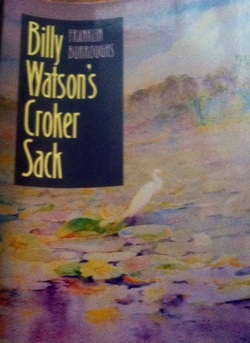
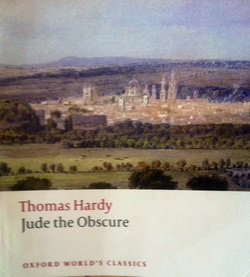
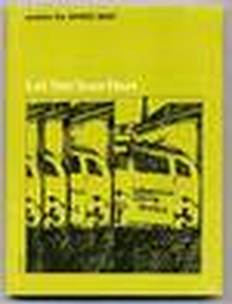

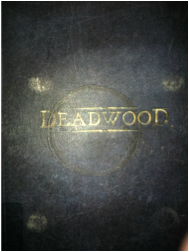
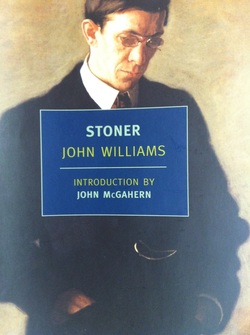
 RSS Feed
RSS Feed
